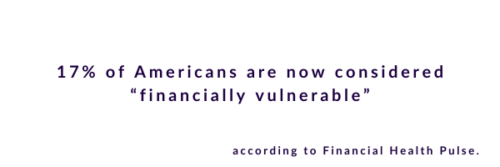Once again, employee financial stress is on the rise. Americans are grappling with higher prices, uneven wage growth and record-high credit card debt. Globally, extremely high inflation has pushed food, fuel and housing costs higher. Household debt coming into 2024 soared to $17.3 trillion, with a notable 16.6% increase between 2022 and 2023 alone. [1]
The Financial Health Pulse 2023 U.S. Trends Report, documents that 17% of Americans are now considered “financially vulnerable,” meaning they struggle to meet expenses, have little to no emergency savings, and carry burdensome debt levels. [2] Compounding these challenges are rising interest rates and the burden of $1.74 trillion in student loan debt repayments. These are collectively straining employee finances and exacerbating overall financial pressure. [3]
Such challenging conditions have had serious implications for Americans’ financial security. Study after study finds that more than half of Americans live paycheck-to-paycheck, including those making over six figures. In fact, data from PYMNTS and LendingClub revealed that 42% of workers earning more than $100,000 per year still struggle with financial insecurity. That underscores the widespread impact of ongoing economic strains on individuals across income brackets. [4]
Financial stress linked to workforce financial (un)wellness
Long-term financial stress has been consistently linked to reduced employee performance. Approximately one-third of employees acknowledge that financial worries affect their ability to engage at work. U.S. employees feel increasingly burdened by financial concerns, spending an average of 8.2 work hours per week dealing with personal financial issues.
In this way, the rise in employee financial stress poses a significant challenge for employers, as it undermines employee well-being and organizational success. Persistent financial strains can result in decreased productivity and diminished employee morale, ultimately impeding the organization’s overall performance.
Recognizing the critical role of supporting employee financial wellness, employers must take proactive measures to alleviate financial stress and fortify the long-term viability of their business.
Generational Perspectives: Financial Stress Across Millennials and Gen Z
- 54% of Millennials and 47% of Gen Z respondents say that financial uncertainty causes feelings of depression. In contrast, just 20% of Baby Boomers and 37% of respondents harbor that sentiment. [7]
- 35% of Gen Z says the cost of living (housing, transportation and utility bills) is their most pressing concern and 51% say they live paycheck-to-paycheck; 42% of Millennials say the cost of living is their most pressing concern and 52% say they live paycheck-to-paycheck. [8]
- While Americans of all ages struggle to pay off debt, Gen Z and Millennials have seen the largest average increases in total debt over the past couple of years. Gen Z saw a 62% increase in credit card debt between March 2022 and February 2024. Millennials saw a 49% increase. These two generations also have had the steepest decline in credit score health. [9]
- A top concern for many Millennials and Gen Z employees remains their looming student debt. As of September 2023, about 43% of Millennials and 28% of Gen Z carried at least some student loan debt. In many cases, these loans have affected the borrower’s ability to meet financial goals. [10] About 60% of US adults with student loan debts have put off making important financial decisions due to their debt. Emergency and retirement savings have taken the biggest hit. When surveyed, 27% of respondents delayed saving for emergencies and 26% delayed saving for retirement. [11]
- While the majority of Millennials want to buy a home, 48% don’t believe homeownership is affordable for their generation. A staggering 96% of Millennial buyers are concerned about purchasing a home. [12]
Generational Perspectives: Financial Stress Across Baby Boomers & Gen X
Baby Boomers tend to report the least amount of financial stress, with only 19% reporting extreme financial stress as of January 2023. [13] This generation also carries a lower average mortgage debt than Millennials or Gen X. However, they have the second-highest credit card debt of any age demographic, after Gen X.
Among the different generations, Gen X exhibits the highest levels of financial worries, with a notable 50.2% expressing feelings of financial insecurity. [14] Almost half of working Gen Xers report feeling significantly behind where they should be with their retirement savings and over half are uncomfortable with their level of emergency savings. Across all generations — from Gen Z to the Silent Generation — financial wellness and security during retirement remains a primary concern. [15]
Understanding the Impact: How Financial Stress Threatens Employee Wellbeing
One of the most concerning elements of financial stress is its negative relationship to physical and mental health. People who are financially stressed are much more likely to struggle with substance abuse, be overweight and have worse health outcomes than their non-stressed peers. [16] They’re also much less likely to be engaged at work.
74% seek financial guidance when dealing with financial decisions, crises, or life. However, only 2 out of 5 employers offer financial wellness programs.
With employees under continued economic strain, other cracks are emerging:
- Many insured adults said they or a family member had delayed or skipped necessary health care or prescription drugs because they could not afford the costs. In the past year: 29% with employer coverage, 37% covered by marketplace or individual-market plans, 39% with Medicaid, and 42% with Medicare;
- 56% of employees said financial stress affected their sleep, 55% their mental health, 50% their self-esteem, 44% their physical health, and 40% their relationships at home. [17]
Employers play a crucial role in understanding and addressing this intersection of financial stress, physical and mental health and workplace engagement. Companies are increasingly called upon to equip their workforce with the tools and resources needed to navigate financial challenges and alleviate the stressors contributing to adverse health outcomes.
Assessing the Influence of Financial Stress on Workplace Turnover & Retention
There’s more bad news for companies struggling to keep employees. As workers face heightened financial stress, there is a pressing need for companies to step up and provide comprehensive support. Otherwise, employers risk losing these employees altogether.
- Financially-stressed employees are twice as likely to change jobs as those who aren’t. [18]
- 73% of financially stressed employees say they would be attracted to another employer that cares more about their financial well-being.
- Among financially stressed employees, 56% spend 3 or more hours per week at work dealing with or thinking about personal finance-related issues.
- Only 54% of financially stressed employees think there is a promising future for them at their current employer, compared to 69% of not financially stressed employees.
Recognizing the need for comprehensive support of employees under financial stress, the focus shifts to employers’ ability to meet these needs effectively. By acknowledging the demand for broader financial wellness initiatives, companies can proactively engage employee satisfaction and retention, paving the way to a more resilient and engaged workforce.
Beyond Retirement: Meeting the Full Spectrum of Employee Financial Needs
The demand for financial wellness support underscores a gap in employer offerings. Many companies only offer retirement support and safety net insurance. However, employees increasingly express dissatisfaction with these limited provisions, highlighting the need for employers to take more comprehensive action in addressing financial stress within their workforce. As employers, it is crucial to recognize and respond to employees’ concerns by expanding financial wellness initiatives.
Seventy-six percent of employees feel their employers should take responsibility for their financial wellness. And 74% actively seek financial guidance for various financial decisions, crises or life events. [19] However, despite this clear demand, only 2 out of 5 employers offer financial wellness programs, even though 68% of employees utilize the financial wellness benefits when provided.
The absence of such support can be a deciding factor for many employees. Some 73% of financially stressed employees saying they would be attracted to another employer that cares more about their financial well-being, compared to just 54% of non-financially stressed employees. [20] It is imperative for employers to recognize their role in equipping employees with basic money management skills and money coaching, budgeting help and other resources that can help employees achieve their financial goals. Furthermore, the benefits are clear: 92% of employers who offer resources to manage overall well-being saw improvement in employee satisfaction. [21]
Best Money Moves can help. Personalized, gamified and easy-to-use, Best Money Moves helps employees budget, make better financial decisions and implement their personal best money moves to achieve their most specific financial goals.
About Best Money Moves
Best Money Moves helps your employees measure and dial down their financial stress, with measurement tools, 900+ written and video resources, and best-in-class voluntary benefits to supplement those you already offer. Depending on the version chosen, you may be able to integrate your own company benefits into the platform, personalizing the financial wellness journey your employees are on.
Call us for a demo and find out how adding a great financial wellness benefit can help improve retention, lower turnover and reduce healthcare costs.
To learn more about Best Money Moves Financial Wellness Platform, let’s schedule a call. Contact us and we’ll reach out to you soon.

